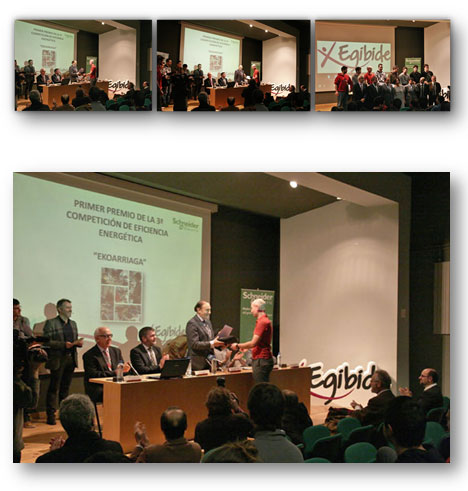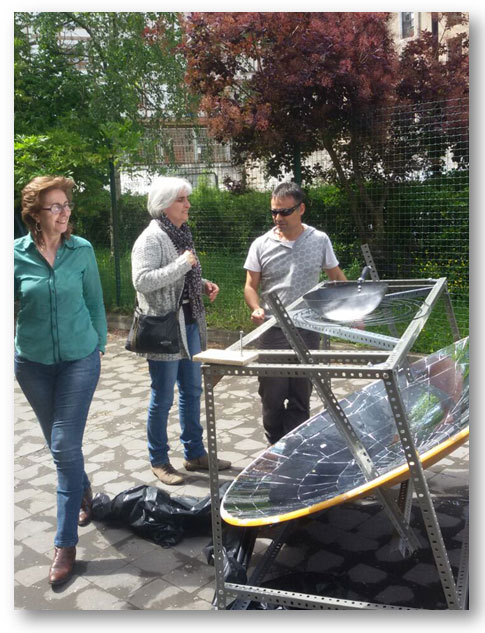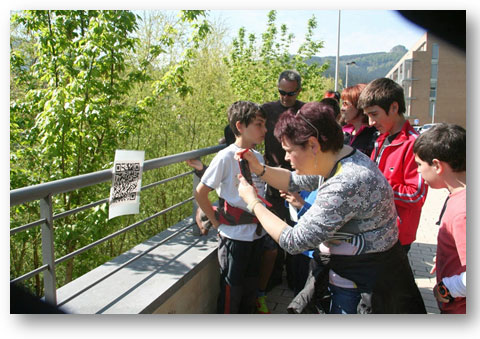IHITZA 46 - Teamwork
I+LED GROUP, AIMING FOR ENERGY EFFICIENCY
After examining the Egibide Arriaga school buildings, in Gasteiz, I+LED Group drew up an energy efficiency project in cooperation with the pupils. It was no ordinary project: in fact, the group won the 3rd Schneider Electric Energy Efficiency Competition. The chairperson of Euskadi School Council also congratulated the pupils on their work. I+LED Group was made up of pupils from the 2nd year of the Associate Degree in Robotics and Industrial Automation Course. They were awarded the prize on January 29th.
Energy is clearly an indispensable factor in producing all consumer goods, but it also creates the most serious environmental problems. So is our current energy model efficient? I+LED Group worked on this project with the conviction that our consumer habits must change, resources must be used in an effective way. Our main objectives were to reduce energy consumption, improve efficiency and use renewable energy instead of conventional sources of energy.

What is energy efficiency?
The project's point of departure and objective was energy efficiency; in other words, improving the ratio between the amount of energy consumed and the products made by using it. So the aim is to save energy, but without losing our current quality of life and production.
Several improvements can be made in the school buildings.
There are three buildings at Egibide Arriaga School: the classrooms building, the workshops building and the sports centre. After in-depth examination of consumption in these buildings, the following data was obtained: during 2013 around 53,000 euros were spent on natural gas and electricity. This is a very considerable expense and, as a lot of energy is wasted, I+LED Group suggested several improvements in its project which affected, for instance, lighting in the classrooms and corridors, heating equipments and thermal isolation.
In most classrooms there are unnecessary fluorescent lights, half of which could be removed. However, instead of taking that measure we suggest replacing the fluorescent lights with LED tubes, which would lead to savings of 60%. Computers, too, consume too much energy: the 225 computers in the buildings spend around 10 hours on standby and consume 10 MW every hour. Contactors and switches could be fitted to turn the computers off at specific times.
A lot of energy is also wasted in the school corridors, sometimes without anybody being there. So we suggest fitting sensors, specifically the KNX domotic system. In addition to this, the heating is always on in the school's main hall, where people only spend a few hours every day. Finding solutions in connection with the lifts, however, is more difficult: in fact, the lift system would have to be changed. Finally, thermal isolation should be used. The windows in the school are old and it would be worth fitting thermal isolation where suitable.

This would lead to annual savings of 16,627 euros.
In order to implement all the measures proposed in the project, the school would have to make an investment of around 18,000 euros. But this would lead to considerable savings in energy and, consequently, economic savings too: 97,883 KW and 16,627 euros, respectively.
As well as working on this project, I+LED Group also took part in several committees and other initiatives. Both teachers and pupils have become interested in renewable energy and energy efficiency and they would like to do more. They have made the school's energy consumption data available for people to be able to take part in different initiatives.
The problems found at Egibide Arriaga may well be shared by other schools and any school can make use of the suggestions in this project. We hope that this project will bring us closer to our objective of achieving energy efficiency.

SUN COOKER, FROM ONDARROA TO AFRICA
 Imagine a cooker which works without electricity or fuel, which just uses sunlight for energy.
Imagine a cooker which works without electricity or fuel, which just uses sunlight for energy.
In many places in Africa local people have to walk long distances every day in order to get firewood for their kitchens, but soon the towns of Dagana in Senegal and Bama in Mali will have three cookers made from parabolic aerials and a dozen cardboard ovens, all made by pupils at Ondarroa Secondary School.
This initiative was carried out as part of Agenda 21's "From Waste Materials to Action" project and the main objective was to find out about values connected with work in cooperation, education and science. This gave Compulsory Secondary Education pupils from Ondarroa the possibility to find out about the importance of cooperation between different institutions and towns.
According to Lourdes Solozabal, who is in charge of Agenda 21 at the school, the main subject this year is based around waste materials created by humans. Various other teachers have also been involved in the initiative.
Javi Crespo, the initiative's coordinator and teacher of philosophy and citizenship, got in touch with the regional government to ask for the parabolic aerials at the old Eitb installations at Iurreta. "They didn't put up any difficulties when we presented the project and brought the five aerials to the school a few weeks later", Javi remembers.
Technology teacher Aitor Aretxaga and Physics teacher Asier Bilbao also took part in the project.
The pupils cleaned the aerials, sanded them down and stuck reflective paper on them. Then they manufactured a support for turning the aerials towards the sun – to the east in the morning and the west in the afternoon – in order to make the most efficient possible use of energy.
Urko Punta NGO is going to send the sun cookers to Africa, but their manufacturers wanted to check that they were working properly beforehand. To do so, they fried six kilos of anchovies on May 23rd, Anchovy Day at Ondarroa, at the place where the fishermen lay their nets out to dry. "It was wonderful weather, the cookers worked excellently and loads of people came along to try our anchovy tapas. And the pupils really took part, which is the main thing."

ICT AND THE ENVIRONMENT
As part of the Agenda 21 project, and with the objective of promoting ecosystem biodiversity, pupils in the 6th year of primary education at Luis Ezeiza School, Eskoriatza, worked on a project called "Ecosystem: The River" from April to June, 2013-2014. Throughout the project they made use of the technological resources provided by Eskola 2.0 and by those which teachers, pupils and their families had at home: smartphones and tablets with Internet connection were used to carry out the project.
Altogether, 32 pupils took part and they were helped Ibarraundi Museum in their research into the river Deba. As well as examining the river water, they also researched invasive animal and plant species.
The project's final aim was to organize guided tours for the pupils' parents. Using new technology and geolocation on the tours, parents had the chance to visit the most interesting places connected with the ecosystem and biodiversity along the river Deba.
The visits were carried out in the morning and in the afternoon, depending on parents' timetables. Their own children welcomed them to the tour and explained what they were going to see.
In the places for examining plants, parents were given access to information about local flora using QR codes; the pupils had prepared the data previously on a blog.
They also used an app called 'eduloc' to get information about animal species. The animals are not usually at those exact places but, thanks to the geolocation system, parents were able to obtain information at several points marked on Google Maps.
It was a very positive experience for both pupils and parents: in addition to the contents under study, they also learned how to use ICT and promote relationships between adults and young people. All of this has led to the school deciding to carry out similar initiatives during the following school year.


